Do Raccoons Live in Packs?
Raccoons do not traditionally live in structured packs but exhibit flexible social behavior. Female raccoons often form matrilineal clusters, while males are more transient, associating briefly for mating or territorial disputes.
Social interactions vary depending on resource availability and environmental conditions, leading to temporary group formations, especially in urban settings where food sources abound. Seasonal behaviors also contribute to varying degrees of sociality, with winter aggregations for thermoregulation and summer solitude due to territoriality.
These dynamics demonstrate raccoons' adaptability and complexity in social strategies under different ecological pressures, and more specific details can further highlight the nuances of their interactions.
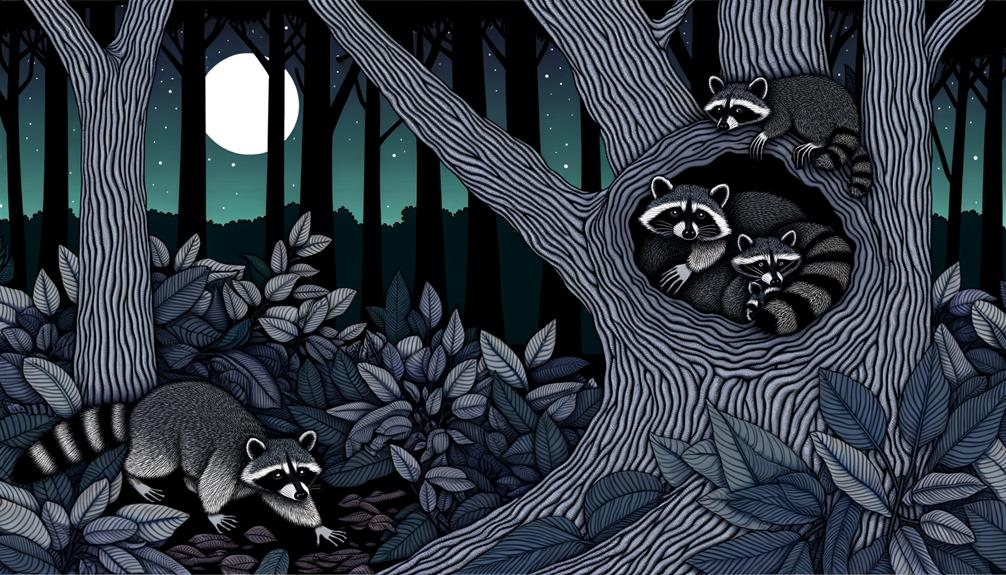
Key Takeaways
- Raccoons exhibit flexible social behavior, forming temporary groups based on food availability and environmental conditions.
- Female raccoons often form matrilineal clusters and cooperate in rearing young.
- Males usually have transient associations, mainly for mating and territorial disputes.
- In resource-rich urban settings, raccoons may display more frequent and flexible group formations.
- Seasonal changes influence raccoon social structure, with winter aggregations for thermoregulation and summer solitude due to territoriality.
Raccoon Social Structure
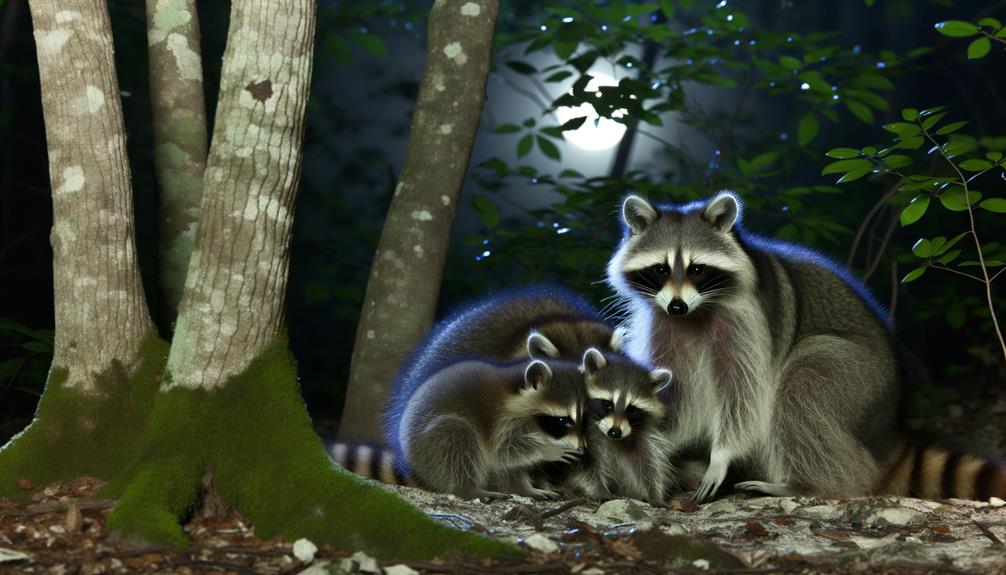
Raccoon social structure is primarily characterized by a loose organization in which individuals exhibit varying degrees of social interactions and cooperative behaviors. These interactions are typically influenced by factors such as resource availability, environmental pressures, and individual temperament.
Research indicates that raccoons demonstrate a flexible social system, where group sizes and compositions can vary considerably. Data from field studies show that female raccoons often form matrilineal clusters, possibly as an adaptive response to optimize foraging efficiency and offspring survival.
Conversely, males exhibit transient associations, often dictated by mating opportunities and territorial disputes. This dynamic social structure suggests a high degree of behavioral plasticity, enabling raccoons to adapt to diverse ecological niches and fluctuating environmental conditions.
Solitary Vs. Social Behavior
The solitary versus social behavior of raccoons encompasses distinct living patterns, interaction dynamics, and seasonal variations.
While raccoons are primarily solitary, data indicate that they exhibit increased social interactions during mating seasons and resource-scarce periods.
Understanding these behavioral shifts provides insight into the adaptive strategies raccoons employ for survival and reproduction.
Solitary Living Patterns
Although typically perceived as solitary creatures, raccoons exhibit a complex range of social behaviors that challenge the traditional dichotomy between solitary and social living patterns. Research indicates that raccoons primarily lead solitary lives, particularly adult males. However, various factors can influence their solitary or social tendencies.
- Seasonal Behavior: Females often exhibit gregarious behavior during the breeding season and while raising young.
- Resource Availability: High food abundance can lead to temporary social group formations.
- Environmental Constraints: Urban settings where denning sites are limited may force raccoons into closer proximity.
These patterns demonstrate that while raccoons are primarily solitary, their behavior can be flexible and adaptive to environmental conditions, blurring the lines between solitary and social living strategies.
Social Interaction Dynamics
Understanding the social interaction dynamics of raccoons requires an examination of the variables that influence their solitary versus social behaviors. Raccoons (Procyon lotor) exhibit facultative social behavior, meaning their sociality is flexible and context-dependent.
Research indicates that food availability, habitat structure, and predation pressure have a significant impact on their social interactions. In resource-rich environments, raccoons may form temporary aggregations to exploit food sources efficiently. Conversely, in resource-scarce conditions, solitary behavior predominates to reduce intra-species competition.
Additionally, conspecific communication through vocalizations and scent marking plays an important role in mediating their social interactions. Studies have shown that female raccoons, especially mothers with offspring, exhibit higher levels of social tolerance compared to males, who are generally more territorial.
Seasonal Group Behavior
Seasonal variations greatly influence whether raccoons exhibit solitary or social behavior. Colder months often prompt increased group cohesion for thermoregulation and resource sharing. During winter, raccoons may form communal dens to conserve heat and ensure survival.
Conversely, spring and summer typically see a reversion to solitary behavior, driven by territoriality and competition for food. Research indicates that raccoons' seasonal social structures are adaptive responses to environmental pressures, enhancing their overall fitness.
- Winter Grouping: Enhanced thermoregulation and resource sharing
- Summer Solitude: Increased territoriality and reduced competition for mates
- Adaptive Responses: Seasonal behavioral shifts improve survival and reproductive success
This cyclical pattern underscores the raccoon's flexible social strategies, vital for thriving in varied habitats and climatic conditions.
Mating and Reproduction

Raccoons exhibit a polygynous mating system, wherein males often mate with multiple females during the breeding season. Mating typically occurs from late January to mid-March, with a gestation period lasting approximately 63-65 days. Female raccoons give birth to litters averaging 2-5 offspring, known as kits, in late spring or early summer.
The reproductive success of males is influenced by their ability to secure and defend high-quality territories, which attract females. Genetic studies have shown that a single litter can have multiple fathers, indicating high levels of promiscuity. Post-copulation, males do not participate in rearing the young, underscoring the solitary nature of their parental roles.
This reproductive strategy maximizes genetic diversity and adaptability within raccoon populations.
Family Units
The social structure of raccoon family units is characterized by intricate dynamics where individuals exhibit cooperative behavior, particularly in rearing their young. Data indicate that both male and female raccoons participate in nurturing offspring, enhancing survival rates.
Observations show that these family units often form temporary yet cohesive groups to optimize resource allocation and protection.
Social Structure Dynamics
Within raccoon communities, family units exhibit complex social structure dynamics characterized by cooperative behavior and hierarchical organization. Research indicates that these units often comprise a dominant female, her offspring, and occasionally related adults. The hierarchical framework is typically influenced by:
- Resource Allocation: Dominant members have priority access to food and shelter.
- Territorial Boundaries: Established territories minimize intergroup conflict.
- Communication Networks: Vocalizations and scent markings facilitate coordination and reinforce social bonds.
These dynamics are essential for maintaining group cohesion and ensuring the survival of the unit.
Data-driven studies have observed that raccoons exhibit a degree of social flexibility, adapting their structure based on environmental pressures and resource availability. This adaptability underscores the evolutionary advantages of their social organization.
Rearing Young Together
Cooperative rearing practices within raccoon family units greatly enhance offspring survival rates through shared responsibilities and collective vigilance. In these family units, adult raccoons, particularly females, exhibit alloparental care where multiple individuals contribute to nurturing and protecting the young. This behavior includes shared foraging, grooming, and nest defense, which collectively decrease predation risks and increase resource acquisition efficiency.
| Role | Behavior | Benefit |
|---|---|---|
| Alloparental | Shared foraging | Increased food availability |
| Maternal | Grooming and nursing | Enhanced juvenile health |
| Sentinels | Nest defense | Reduced predation risks |
The cooperative dynamics within these units are crucial for the young raccoons' development, ensuring higher survival probabilities and better adaptation to environmental challenges.
Juvenile Raccoons
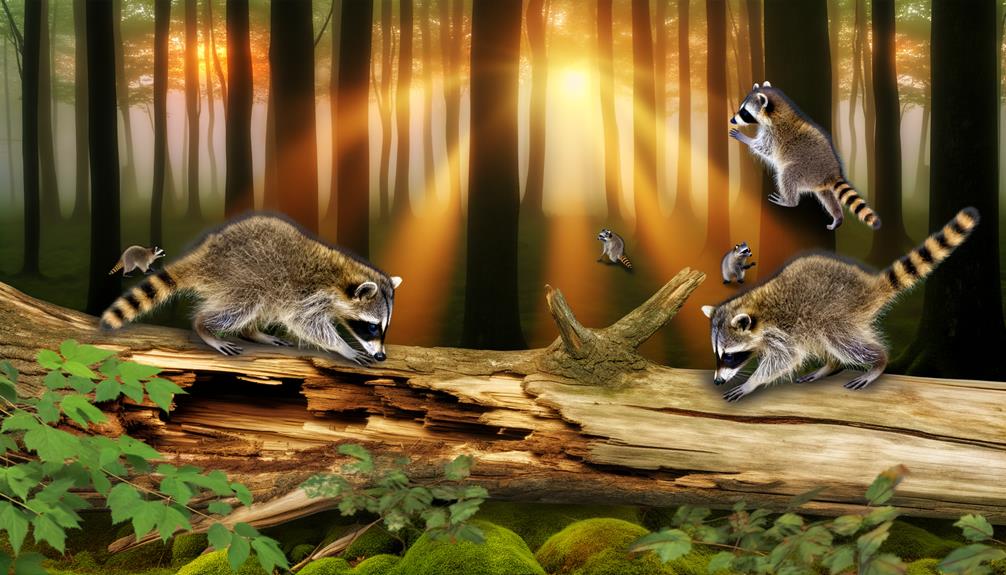
Juvenile raccoons exhibit distinct behavioral patterns and developmental milestones that are vital for their integration into pack dynamics. These young raccoons, typically aged 2-12 months, undergo significant growth phases that shape their social and survival skills.
Research indicates that juvenile raccoons engage in specific behaviors to enhance their adaptability, including:
- Play behavior: Essential for developing motor skills and social hierarchies.
- Foraging practice: Gradual shift from maternal dependency to independent food acquisition.
- Vocalization: Communication skills developed through varied sounds to signal distress, contentment, or warnings.
Data suggests that juvenile raccoons benefit from these interactions by fostering cooperative behaviors and reducing juvenile mortality rates. Understanding these dynamics is vital for comprehending the social structure and cohesion within raccoon packs.
Territory and Range
Territorial and ranging behaviors in raccoons are critical factors that influence their social structure, resource allocation, and survival strategies.
Raccoons typically establish home ranges that vary in size from 3 to 20 square kilometers, depending on resource availability and population density.
Home ranges of adult males often overlap with multiple females, while females maintain exclusive territories, particularly during the breeding season.
Seasonal variations also impact range size, with larger territories observed during periods of resource scarcity.
Raccoons utilize scent marking to delineate territorial boundaries, reducing direct conflicts.
Studies indicate that urban raccoons exhibit smaller home ranges due to higher resource concentration, whereas rural raccoons cover more extensive areas.
Understanding these behaviors is pivotal for effective wildlife management and conservation efforts.
Communication Methods

Raccoons employ a range of communication methods to maintain social cohesion within their packs. These methods include a variety of vocalizations and sounds, such as purrs, growls, and screeches, each serving distinct purposes.
Additionally, raccoons utilize body language signals, including specific postures and gestures, to convey information and coordinate activities.
Vocalizations and Sounds
In raccoon packs, a diverse array of vocalizations and sounds serve as vital communication methods to convey information and coordinate group activities. These auditory signals are essential for maintaining social cohesion and ensuring the survival of the group.
Raccoons utilize a range of sounds, each serving distinct functions:
- Chirping: Often used by young raccoons to communicate with their mothers, indicating hunger or distress.
- Growling: Employed during aggressive encounters, growling helps to establish dominance or ward off potential threats.
- Purring: Typically observed during grooming or resting, purring fosters bonding and signals contentment among group members.
Scientific studies have recorded over 200 distinct vocalizations in raccoons, underscoring the complexity of their communication systems.
Body Language Signals
Beyond vocalizations, raccoons also employ a sophisticated system of body language signals to facilitate communication and maintain group dynamics. These signals include postures, movements, and facial expressions, which convey specific information regarding social hierarchy, territorial boundaries, and emotional states. Observational studies have documented a range of non-verbal cues that raccoons use in various contexts, enabling efficient intra-group interaction without resorting to vocal calls.
| Behavior | Interpretation |
|---|---|
| Tail Positioning | Indicates social status or alertness |
| Ear Movement | Signals attention or agitation |
| Body Postures | Conveys dominance or submission |
| Facial Expressions | Reflects emotional states (e.g., aggression, fear) |
| Grooming Behaviors | Strengthens social bonds |
Understanding these body language signals is essential for comprehending raccoon social structures and their adaptive communication strategies.
Feeding Habits
Feeding habits of raccoons are characterized by their omnivorous diet, which includes a wide variety of plant and animal matter. Their dietary adaptability contributes to their survival across diverse habitats. Raccoons exhibit nocturnal foraging behaviors, utilizing their dexterous front paws to manipulate food sources.
Their diet comprises:
- Plant Matter: Fruits, nuts, and berries.
- Animal Matter: Insects, small mammals, and amphibians.
- Aquatic Sources: Fish, crayfish, and other aquatic invertebrates.
Studies indicate their preference for high-energy foods, especially during the fall to accumulate fat reserves for winter. Raccoons display opportunistic feeding strategies, often exploring new food sources. This versatility aids in their ecological adaptability, enabling them to thrive in various environments.
Urban Vs. Wild Settings
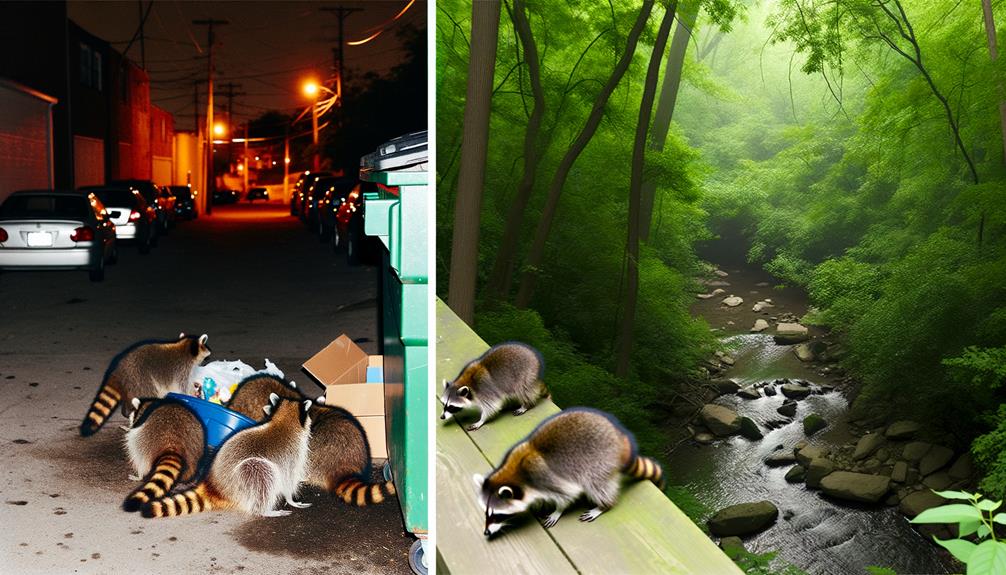
Raccoons exhibit distinct behavioral and ecological differences when residing in urban environments compared to wild settings. In urban areas, raccoons demonstrate increased nocturnal activity, likely due to the availability of anthropogenic food sources and reduced predation pressures. Studies indicate higher population densities in urban locales, with some estimates showing densities up to 20 raccoons per square kilometer.
Conversely, in wild settings, raccoons maintain more solitary behaviors, with population densities considerably lower, often around 1-2 raccoons per square kilometer. Urban raccoons also show adaptations such as altered foraging strategies, utilizing human waste and residential areas, whereas wild raccoons primarily rely on natural food sources. These ecological pressures influence social structures, with urban raccoons exhibiting more flexible, albeit transient, group formations.
Seasonal Behavior Changes
Seasonal variations greatly influence the activity patterns, foraging behaviors, and reproductive cycles of raccoons. During warmer months, raccoons exhibit increased nocturnal activity, taking advantage of abundant food resources. Conversely, in colder seasons, their metabolic rate decreases, leading to reduced activity and semi-hibernation states.
Reproductive cycles are also closely tied to seasonal changes, with mating typically occurring in late winter and early spring.
Key seasonal behavior changes in raccoons include:
- Activity Levels: Higher in summer, lower in winter.
- Foraging Patterns: Shift from diverse diets in warm months to reliance on stored fat in cold months.
- Reproduction: Mating in late winter, with births occurring in spring.
These adaptations help raccoons maximize survival and reproductive success throughout the year.
Interaction With Other Species
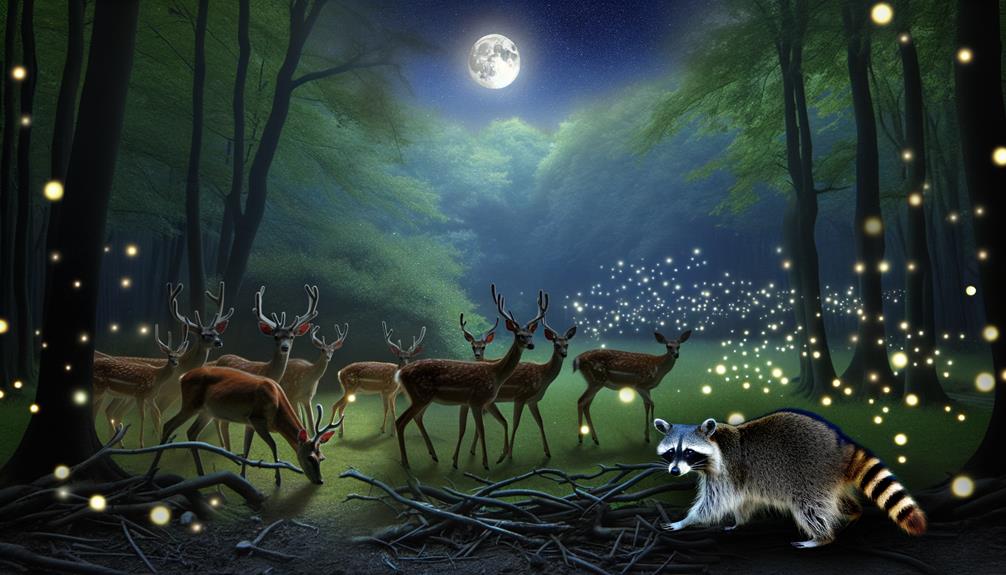
Engaging in various interspecific interactions, raccoons exhibit both competitive and symbiotic relationships with numerous other species within their habitats. Competition is frequently observed with other omnivores such as opossums and skunks, primarily over food resources. Raccoons are known to raid bird nests, impacting avian populations negatively.
Conversely, their role in seed dispersal facilitates plant biodiversity, offering a mutualistic relationship with certain flora. Additionally, raccoons can indirectly affect predator-prey dynamics; for example, their foraging can reduce insect populations, influencing bird feeding patterns.
In urban settings, raccoons often exploit human waste, which can lead to increased encounters with domestic animals. Understanding these interactions provides insight into the ecological balance and adaptive strategies of raccoons in diverse environments.
Research Findings
Recent studies have revealed significant insights into the social structure and behavioral patterns of raccoons living in packs. Research indicates that raccoons exhibit complex social behaviors, often forming loose-knit groups based on resource availability and habitat conditions.
Observational data and GPS tracking have provided evidence of:
- Group Foraging: Collaborative foraging strategies enhance food acquisition efficiency.
- Resource Sharing: Shared den sites and food caches reduce individual energy expenditure.
- Social Learning: Younger raccoons learn survival skills through interactions with more experienced group members.
These findings underscore the adaptability of raccoons in urban and rural settings, suggesting that pack dynamics play a critical role in their survival and ecological impact.
Further research is needed to explore the nuances of these interactions and their long-term effects on raccoon populations.
Conclusion
Raccoons exhibit both solitary and social behaviors. Social structures vary based on environmental conditions. While mainly solitary, raccoons form temporary family units during the breeding season and juvenile rearing.
Research indicates that urban raccoons demonstrate increased social interactions compared to their wild counterparts, likely due to resource availability.
Seasonal changes also influence raccoon behavior. Winter prompts more communal denning.
Despite occasional social tendencies, raccoons do not form stable packs, maintaining a primarily solitary lifestyle.






